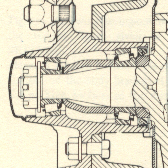Simplified
Wheel Bearing Installation
 As
of: 14 October 2003
As
of: 14 October 2003 
Many of you have worried and worked for hours trying to get the right
combination of shims on the front wheel bearing spacers of your MG. Just
when you think you have it nailed, you find that the cotter pin hole can't be
lined up when the nut is torqued properly. Well, all your labors were for
nothing. Why does your MG, and maybe some other British cars, have the spacer
and shims when billions of other cars with front wheel bearings do not? The
answer is simple. You don't need them. You could tie the spacers on a string
and drag them around behind you and they'd do just as much good as they do in
that hub.
Nearly all other cars in the world have wheel bearing configurations exactly
like your MG, except, they have no spacer or shims. They say the shims are for
setting the bearing "float", but you get the same float with or
without the shims. With the shims you work to a torque spec, without them you
don't.
To
be in step with the rest of the world leave the spacer and shims out. Tighten
the nut good and snug, turn the wheel a half turn or so, loosen the nut, and
turn it right lightly until you feel it make contact. Wiggle the wheel and if
you feel any play or looseness tweak the nut a little tighter until that play
is gone. If the cotter pin hole doesn't line up back off to the first cut in
the nut that will. Some spindles have two cotter pin holes, one vertical and
one horizontal. Catch the closest one you can and insert the pin.
The
reason for tightening the nut and turning the wheel the first time is to press
any excess grease from between the rollers and the cup. When you back the nut
off and re-set it lightly there will be a slight float, but you won't feel it.
Sometimes you can after the car has been driven a few miles. Most cars have no
cuts on the nut, but have a "tin" nut with cuts for the cotter
pin that slips over the "real" nut. You have infinite
adjustment with them. My MGB is the only car I ever worked on that had shims
in there. No other car, trailer, tractor, or anything else had them, nor needs
them, and the bearing, spindle, and hub configuration is the same as an MGB.
The only cars I ever worked on that required a bearing float that you could
feel were '40s and early '50s Chevy's that had ball bearing front wheel
bearings. The shims in an MGB are overkill, I've never worked on even an
airplane that had them.
Those bearings are going to do exactly the same thing with or without the
shims. Those cones don't float on the spindle either way, the angles on the
bearings take care of that.
|
Look at this picture, study it a while,
think about it.
It all comes out the same with or without the shims, it's just
that the conventional way of adjusting them is much quicker and easier. The
taper on the bearings assure everything will work as it should, shims or no
shims, so long as the preload or float is adjusted properly. The key word
being properly, not precisely, this isn't rocket science you have a little
leeway. |
 |
Knowing what you have just learned can save you a lot of time and toil the
next time you get into your front wheel bearings. Install the spacers and
shims if you simply must have it by "the book", but my book and
thousands of others don't have them.
John
Dandy
(theAutoist
NOTE: John Weimer's new "nom de plume")
|
![]() As
of: 14 October 2003
As
of: 14 October 2003 ![]()
